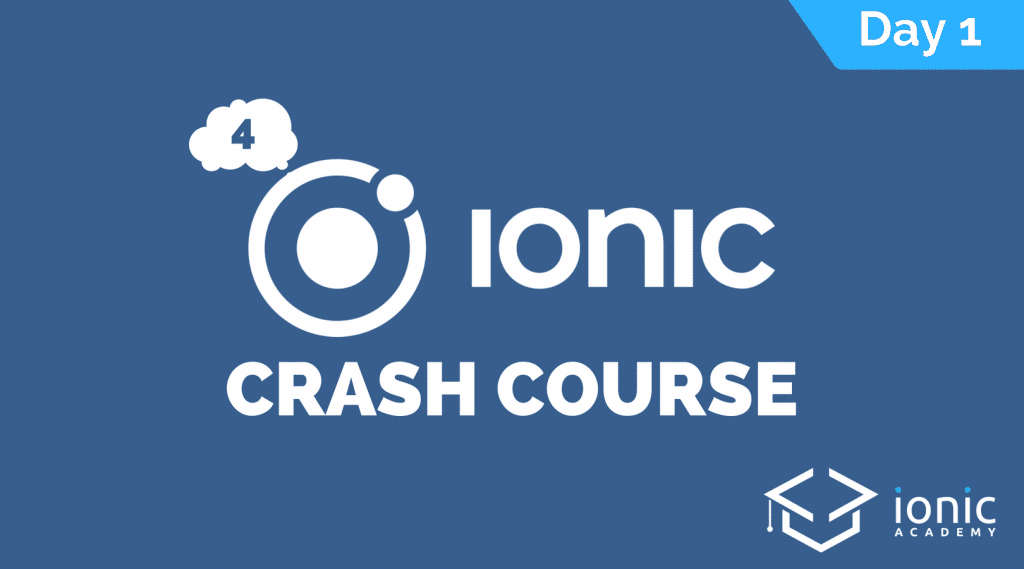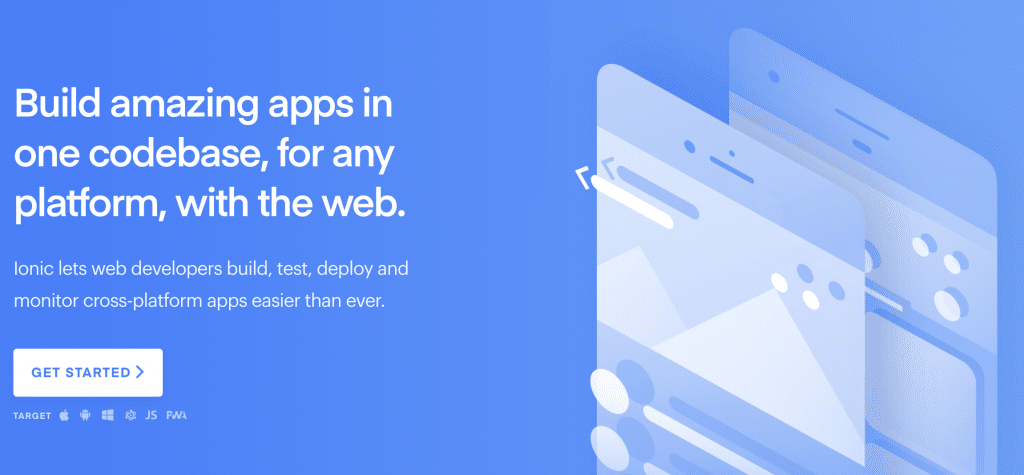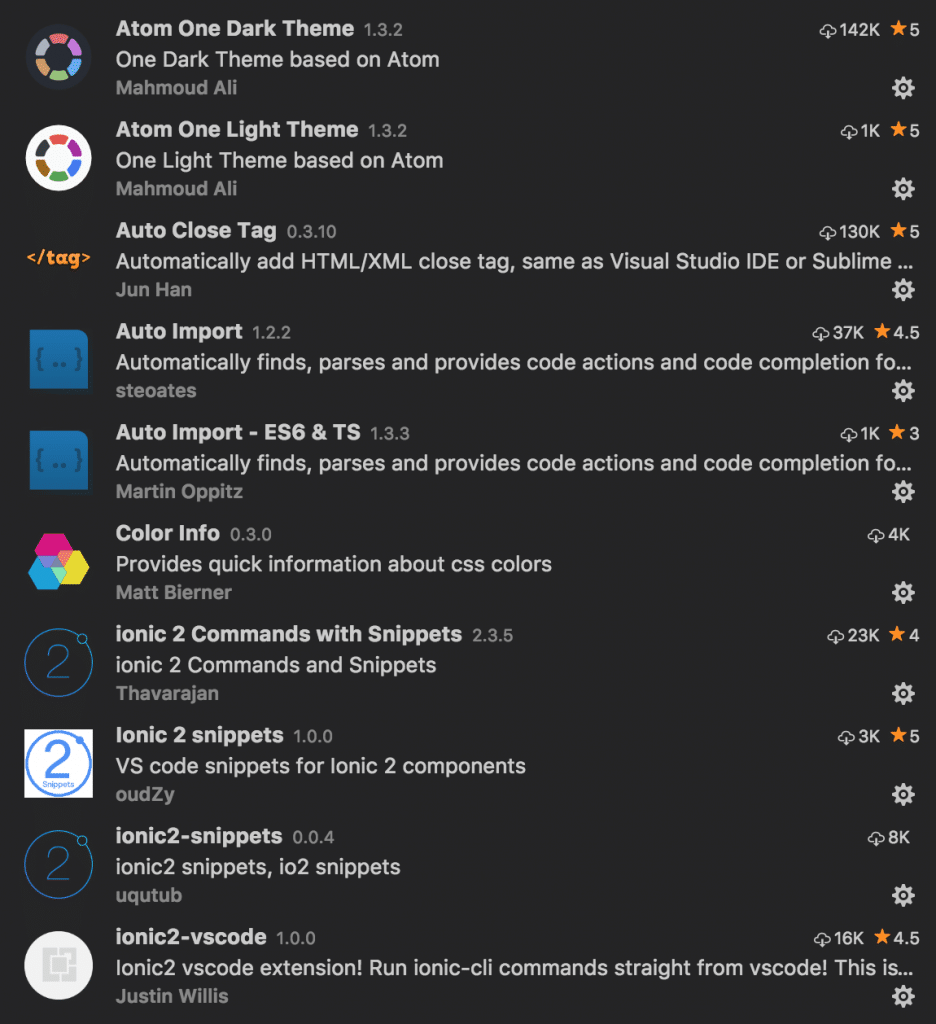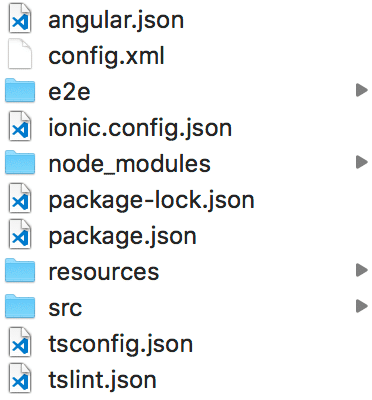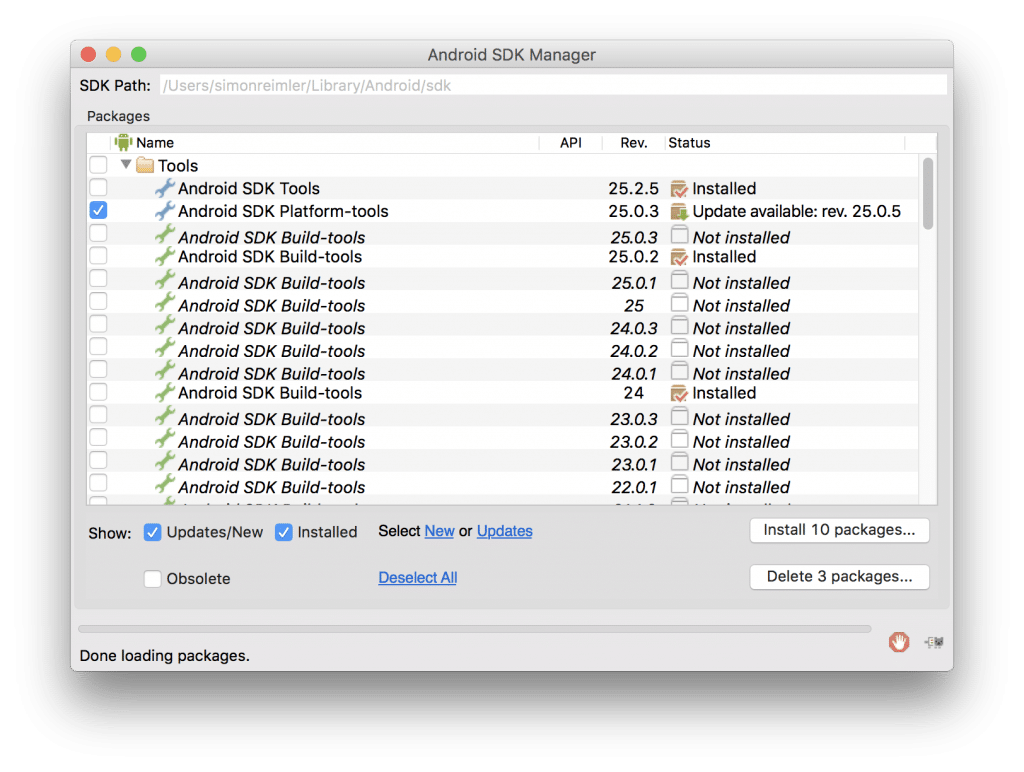Welcome to the 1. lesson of the Ionic Crash Course!
Today we will start at ground zero, which means getting to know Ionic, setting up our environment, getting a first Ionic app up and running and taking a basic look at what we got inside our app folder.
Finally we will also take a short look at how Angular plays with Ionic, how our files are connected and how we can add our first elements. Oh, and of course we will deploy our app to iOS and Android devices!
You see, quite a few things for one lesson so let’s get started!
1. What is Ionic?
Before we dive into the technical side, a few words on Ionic if you have no idea what we are talking about.
Ionic is a framework that allows us to develop mobile apps using web technologies – HTML, CSS and Javascript basically.
The app is running inside a webview, but of course you don’t see a navigation bar inside that app later!
Through Cordova our “webview app” get’s packaged into a native iOS or Android project, and from that point on you can deploy it like you could any other native app.
With Ionic your app is built from one single code base, and the apps are often referred to as Cross Platform Apps or also Hybrid Apps (although the latter has a bitter taste for some people).
I guess you came here because you already know a bit about it and are interested in more, if you still want more general information just check out the official Ionic page!
2. Installing Ionic & Environment
To work with Ionic we need to install a few packages on our machine. Perhaps you already have some of the following, otherwise make sure your environment is set up after those steps!
Node.js
Whether you are using Windows, Linux or Mac the first step is to make sure you have Node.js installed on your machine.
If you haven’t, simply go to the official Node.js page, pick the right package for your machine, download and finally install it.
Ionic
Ionic can be installed as a Node.js package through the Node Package Manager (npm) directly from our command line. On a Mac, you can open the Terminal, on other machines use the according Shell and run this command:
|
1 |
npm install -g cordova @ionic/cli |
You might have noticed there are a few more words in this command. So besides the ionic package we also install cordova, which we need to build our apps into native projects for iOS or Android. But more on that to a later point, for now just make sure this command runs successful!
Oh, and the “-g” option means to install the package globally on your machine, not just in your current folder!
Code Editor
My favorite code editor at this time is Visual Studio Code.
It’s exactly what we need to work with HTML, CSS and JavaScript and many extensions make this really an awesome code editor.
Of course you can use something else like Sublime, Atom or whatever you prefer, but I still recommend you give VSC a try!
Many people have previously asked for my theme and plugins inside VSC, so if you are interested you can install the ones you see in the images below!
After installing Ionic through Node you should be able to successful run this command from your command line:
|
1 |
ionic info |
This should print your current versions of different things, and if you have a problem it’s always a good idea to mention those versions as problems might occur only in specific versions at some time!
For me this looked like this (at the point of writing this):
[WARN] You are not in an Ionic project directory. Project context may be missing.
Ionic:
Ionic CLI : 6.3.0
Utility:
cordova-res (update available: 0.11.0) : 0.9.0
native-run : not installed
System:
NodeJS : v13.9.0
npm : 6.13.7
OS : macOS Catalina
If some of your values are different that’s no problem. The most important part here is that Ionic is installed correctly and the command line interface (CLI) works properly.
3. Starting Your Ionic App
We are now ready to start the first project – already a bit excited?
I am always when I start a new one.
Simply navigate to a folder where you want to start your app and run this command from your command line:
|
1 |
ionic start ionicStarWarsApp blank --type=angular |
The CLI will ask if you want to include Capacitor, and for now we will choose no since we want to use Cordova in this course first of all.
This might take a bit depending on your connection, 1-2 minutes are completely normal as it will install quite a few packages!
What this command does is downloading a template for a new “blank” Ionic app and installing all the dependencies the framework needs. The project name will be “ionicStarWarsApp”, so if you want a different name pick something else.
The type specifies the JS framework used in our app. Since Ionic 5 there’s also React support, but we will stick with Angular since this is the framework we used in previous Ionic versions and also what’s used inside the Ionic Academy courses!
Once this bootstrapping process is done you can navigate into your folder (cd ionicStarWarsApp) and directly serve your app – but first only inside your browser running:
|
1 |
ionic serve |
This will compile the project and run it on a local server. You don’t have to take care of anything here, just sit and wait..
And finally your browser should open with a view looking like this:
That is a very good sign, because you have just created and started your first Ionic app!
This is the preview function which you will use 95% of the time to develop your apps – and it’s unbelievable fast.
If you are a former native developer, this will feel so much faster, and if you are coming from web development you feel right at home!
Since version 4 the previous lab package is not included by default so let’s install it now and run it afterwards:
|
1 2 |
npm i @ionic/lab ionic lab |
This will bring up a slightly different view that already shows your potential app inside a nice app container like this:
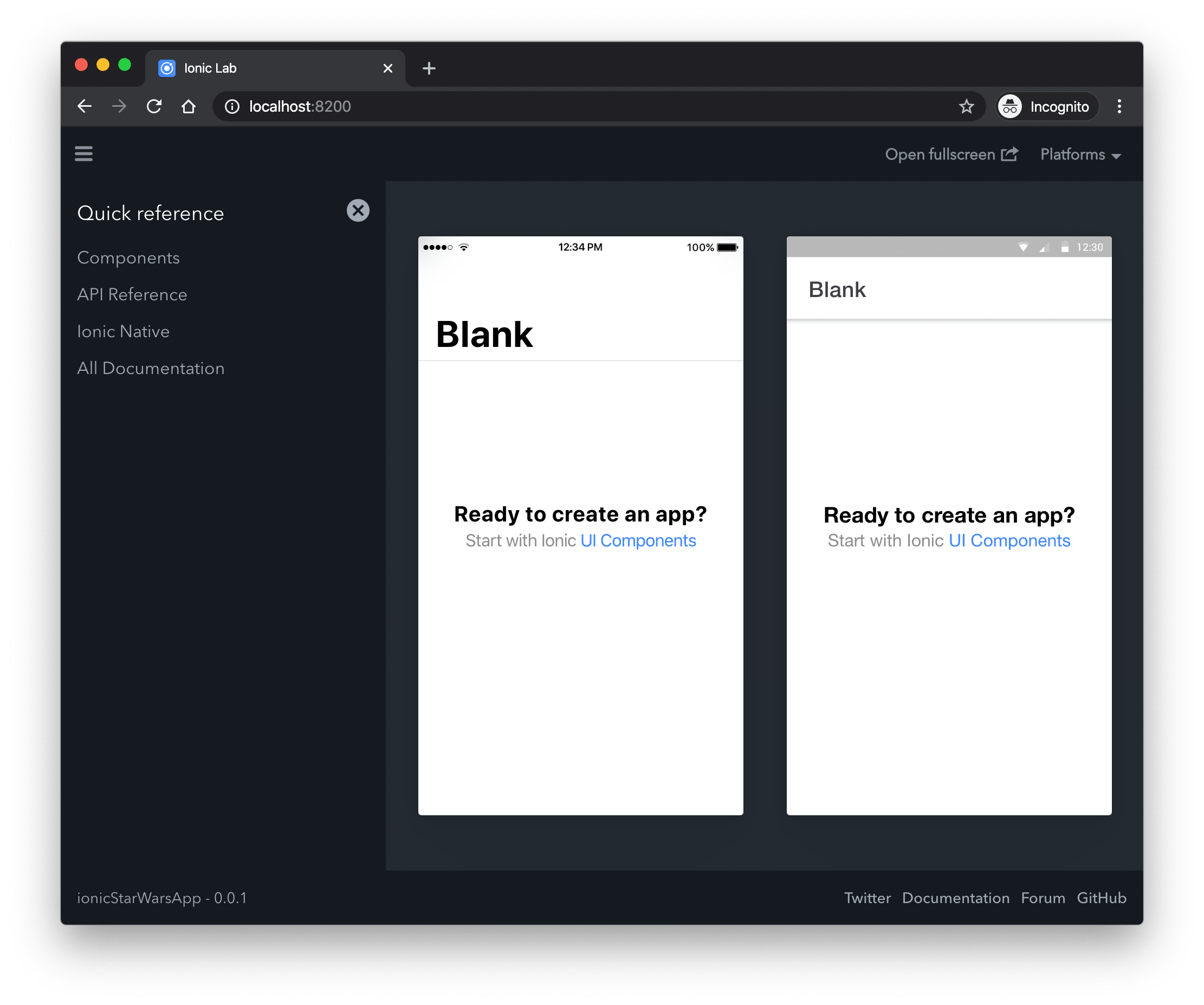
At the top right corner you can pick which platform you would like to see the preview for – different platforms will automatically have a different styling (but more on this in a later lesson)!
For now we leave that view and take a look at what we have actually downloaded and bootstrapped before.
4. Ionic Project Structure
The files inside of your folder might look quite scary and overwhelming if this is your first encounter with Ionic or an Angular project – but most of the time you will be working only in the src folder and can forget about the rest!
Your app folder will look very likely look like the one in the image below.
So what is all of that?
The angular.json holds configuration values for our Ionic/Angular project and you don’t really need to touch or change it in the beginning.
The e2e folder holds the configuration for our testing setup that’s already included, but if you don’t plan to use testcases (which you definitely should at a later point) you can ignore the folder for now.
The ionic.config.json contains some basic information about your project and is used if you upload your app to the Ionic Pro platform.
The node_modules folder is automatically generated once you install the npm dependencies with “npm install” (Ionic already did this for you in the beginning). This command will scan the package.json for all the packages that need to be installed and is a classic Node.js file.
The package.json is a file that you will find in all Node projects. This file specifies which additional packages should be installed and helps to share you project, because other developers can simply install the dependencies of that file and their environment is ready as well!
The src folder is the most important folder, and 99% of your work will happen in that folder. It’s the folder that contains your actual Angular code!
The next three files (tsconfig.json, tsconfig.app.json, tslint.json) are related to TypeScript and how it gets compiled. We don’t really have to care for them, just keep them like they are and you are fine.
Once you add a platform (we will do this soon) you will also notice two more folders:
The platforms folder contains your native projects. You need to add them first (we will see how later) and they will be generated to this folder.
The plugins folder contains all the Cordova plugins that you installed. As you might know, these are the wrapper around native functions and we will use some of them later in this course.
With the knowledge about all of these folders we can dive into what is actually our app and change a few things!
Working With Angular
Until now we haven’t seen much of the code – so let’s change that!
As said before, we are working inside the src folder of your project, therefore we inspect what we currently got.
The app folder is more or less the entry point of your app. Everything inside that folder is used when your app is bootstrapped. This folder works in combination with the index.html, which also imports some stuff and has this part somewhere inside the body of your HTML:
|
1 2 |
<!-- Ionic's root component and where the app will load --> <app-root></app-root> |
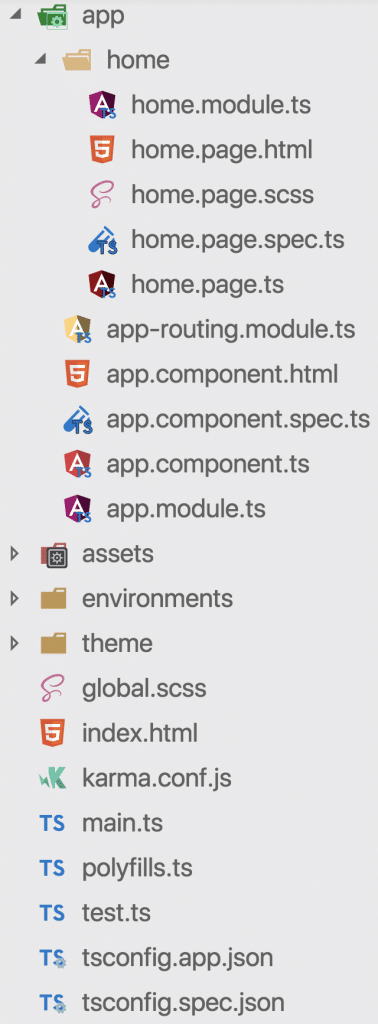
This is the place where your app will be loaded into!
You rarely have to touch that file, but it’s good to know how everything works.
We’re not going deeper into the module files for now, we already covered quite a bunch of knowledge in this lesson so let’s get to where the fun is.
Our App is made up of different components or also called pages, and after starting our app we already have one page inside the folder called home.
Every page will have its own folder with a HTML, SCSS, module TS file, page TS file and also a spec file for testing. The one thing new here might be the filetype TS which stands for TypeScript.
Typescript
TypeScript is a superset of JavaScript which most important adds Types to our variables like void, string or boolean.. Yeah, Javascript doesn’t suck like some years ago!
We will always code in TypeScript and the build system will transpile this code into plain Javascript which every browser can understand. Again, don’t worry about that part, it just happens under the hood.
Angular Data Binding
We saw that each page consists of different parts – and they are of course connected. Within the SCSS file you can define styling for your view, the HTML page represents your view and the Page TypeScript file contains the class that is associated with your view.
The connection between view and class comes from Angular and we don’t have to add anything to get it working. Your home.page.ts will most likely look like this:
|
1 2 3 4 5 6 7 8 9 10 |
import { Component } from '@angular/core'; @Component({ selector: 'app-home', templateUrl: 'home.page.html', styleUrls: ['home.page.scss'], }) export class HomePage { } |
For Javascript or web developers this looks very object oriented and for native developers it looks also kinda familiar – and it is!
The @Component decorator is used internally by Ionic and Angular and we don’t have to change anything here, the imports at the top import different components from other NPM packages and you’ll see some more of them during the next days.
Inside our class we can define variables like in all other languages, so go ahead and change your class to this:
|
1 2 3 4 5 6 7 8 9 10 11 12 |
import { Component } from '@angular/core'; @Component({ selector: 'app-home', templateUrl: 'home.page.html', styleUrls: ['home.page.scss'], }) export class HomePage { myVariable: string = 'The force is with me!'; } |
We already define that our variable is of a specific type (which we don’t need to do, but it’s a good practice) and assign a basic string to it.
Now how to show it from the view?
We can access this variable through Angulars data binding by using double brackets “{{” and “}}” inside our HTML view. Therefore open your home.page.html and change it to:
|
1 2 3 4 5 6 7 8 9 10 11 12 13 |
<ion-header> <ion-toolbar> <ion-title> Ionic Blank </ion-title> </ion-toolbar> </ion-header> <ion-content class="ion-padding"> {{ myVariable }} </ion-content> |
We don’t mind all the other HTML tags right now and only focus on the marked line – which loads the value of our class right into the view!
If you have the preview still open and save your file, you will see that a reload is triggered. That’s because Ionic uses live reload, and whenever you make changes those are immediately reflected inside the preview!
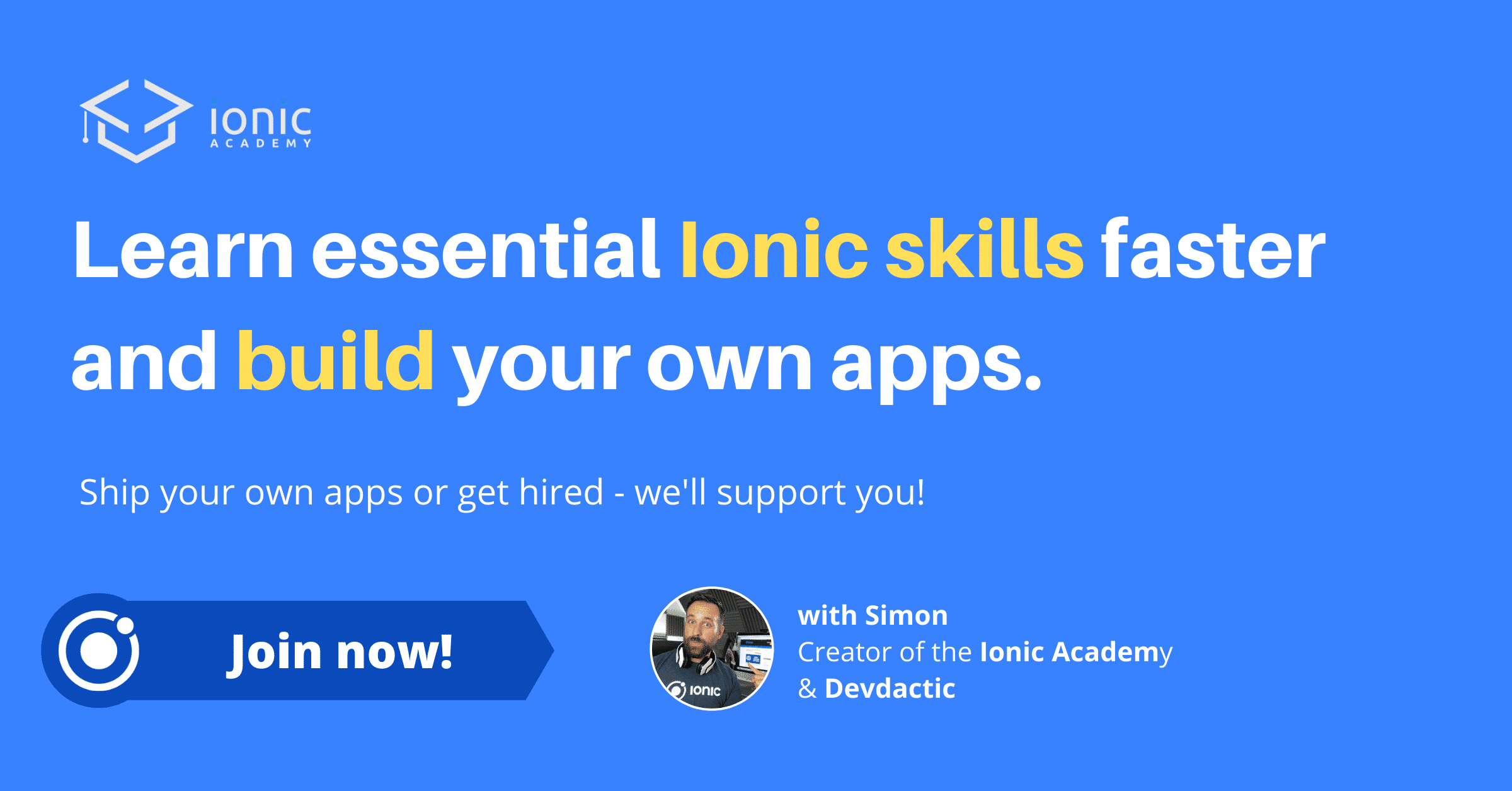
Angular Events
Ok it’s pretty static to just see the string, so we add a button and call a function to change the string to something else!
We start with our class where we implement a function that changes our variable. We can access all the variables of a page by using this, so change your class to look like this:
|
1 2 3 4 5 6 7 8 9 10 11 12 13 14 15 |
import { Component } from '@angular/core'; @Component({ selector: 'app-home', templateUrl: 'home.page.html', styleUrls: ['home.page.scss'], }) export class HomePage { myVariable: string = 'The force is with me!'; updateMyValue() { this.myVariable = 'Now the force is even stronger!'; } } |
I think how a function works should be quite clear to you.
But how to call it from the view?
We need to add a button using Ionics components (which already have some basic styling!) and tell it to call the function once someone clicks that button.
Therefore, open the home.page.html again and change it to:
|
1 2 3 4 5 6 7 8 9 10 11 12 13 14 15 |
<ion-header> <ion-toolbar> <ion-title> Ionic Blank </ion-title> </ion-toolbar> </ion-header> <ion-content class="ion-padding"> <ion-button expand="full" (click)="updateMyValue()">Click me!</ion-button> {{ myVariable }} </ion-content> |
Besides creating an ion-button(which is one of Ionic components) which should expand to the full size of the view, we also specify what should happen on a click event – in this case the function of our class will be called.

You might now notice that when you click the button the value of the view is directly updated. This is again automatically working thanks to the data binding of Angular between view and class!
Enough of all of this for now – you can of course play around a bit more with the code, HTML and Angular but actually we have only seen our app inside the browser. Wasn’t the goal here to build mobile apps? Hell yeah!
5. Preparing iOS & Android Environment
If you want to build your app into a native package, you need again a few things.
Note: If you are not on a Mac you can’t build your app for iOS! This is simply not possibly yet due to how iOS works.
Build for iOS
Open the App Store on your Mac and search for “Xcode“. This is the native development environment for iOS developers and we can use it to try out our app on iOS devices.
Don’t worry, you don’t really have to learn how it works, a few buttons are enough to get us started there.
We also need 2 additional packages in order to build the app from the command line, so go ahead and install them now:
|
1 2 |
npm install -g ios-sim npm install -g ios-deploy |
After installing Xcode (which is free) you can run directly inside your Ionic project the command to build everything into a native project:
|
1 2 |
ionic cordova platform add ios ionic cordova build ios |
The first command needs to be called only once for a project, and it sets up the iOS platform for the project.
This might take a few moments and once done, you will find that inside the platforms folder you now got a iOS project.
To open the project in Xcode double click the ionicStarWarsApp.xcodeproj, which will bring up Xcode. If you click on the project on the left side the general view opens which should look like this:
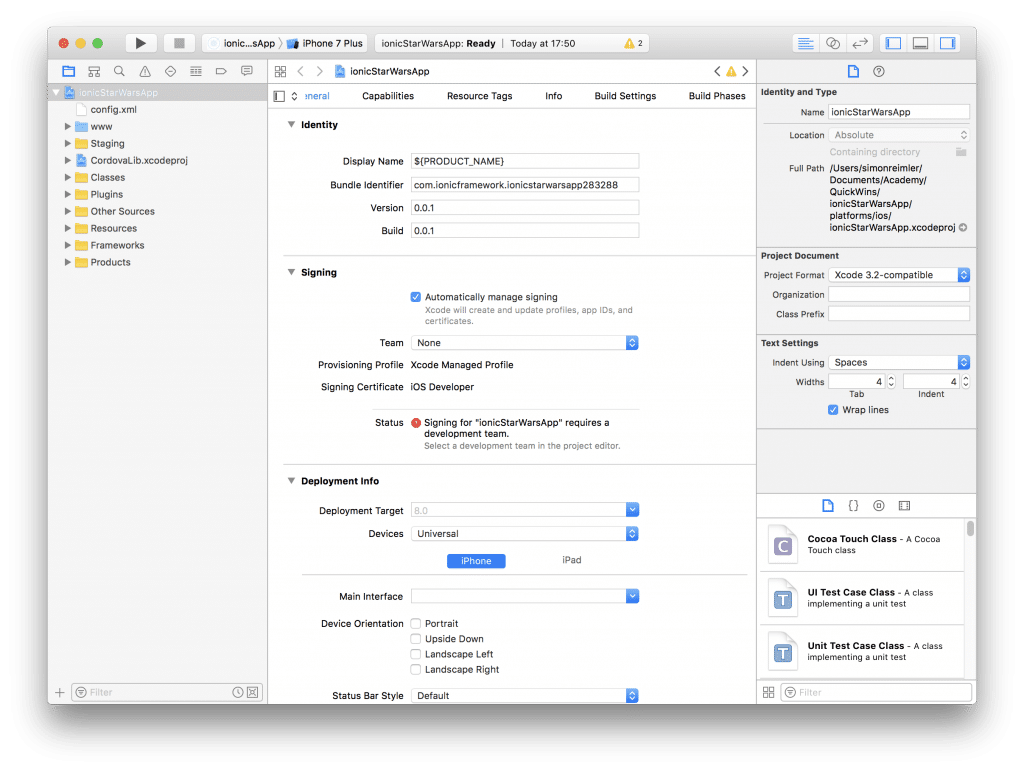
At the top left next to the run button you now see the name of your project and the currently selected simulator. You can now hit the run button to deploy your app to an iOS simulator and get the feeling of a native app!
If you want to deploy your app to your iPhone, you can connect it through USB and it will appear at the top of that list above the simulators.
Congratulations, you’ve now started, built and run your Ionic app on a native iOS device!
Build for Android
I guess the majority of you is more interested in Android (also due to the absence of a Mac).
For Android, it’s a good idea to download the official environment Android Studio. This will help you to install the Android SDK which is needed now.
After installing Android Studio open it and inside the Wizard click Configure and pick SDK Manager.
This will bring you to a view where you can install an Android SDK – simply pick the newest one and install what you need!
Now we can add the Android platform to our project just like we did before for iOS, so go to your command line and run:
|
1 2 |
ionic cordova platform add android ionic cordova build android |
This results in a new Android project inside the platforms folder. You can now either go ahead and import this project into Android Studio or directly install it to your Android device if it’s connected with USB.
Ionic already told us the path to the generated APK after the build command.
If you have followed the course so far, this should be:
/platforms/android/app/build/outputs/apk/debug/app-debug.apk
You can now use the Android Debug Bridge (ADB) to install it by running:
|
1 |
adb install platforms/android/app/build/outputs/apk/debug/app-debug.apk |
This will install the App on your device and you got your first Ionic app in your hands!
6. Recap
Congratulations if you made it this far!
I’m taking the Ionic Crash Course and love it! Click To TweetWe’ve taken the first steps of Ionic together, and from now on things will actually get a lot easier. In the next lesson we will get more into code and simply use the preview function of Ionic.
But now you are completely ready to develop and build mobile apps for iOS and Android using Ionic!
